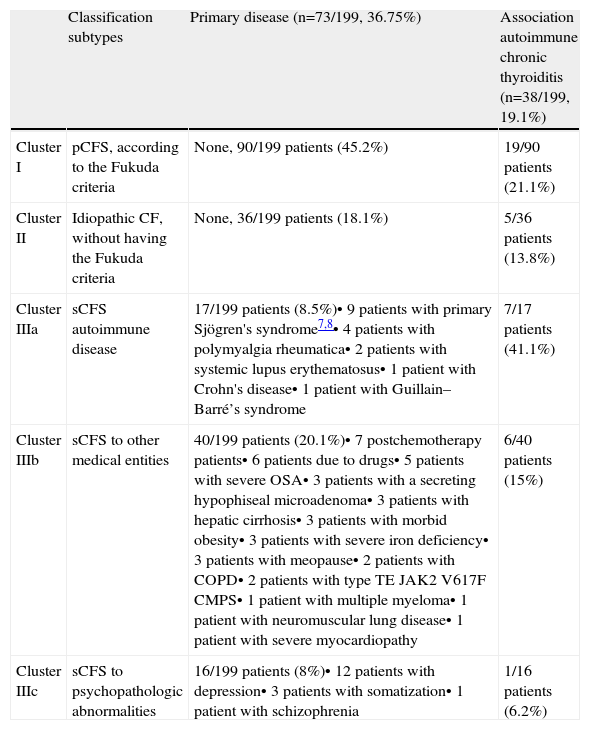Primary (or pure) chronic fatigue syndrome (pCFS) is a complex and severe chronic and disabling disease of unknown causes, excluding secondary chronic fatigue syndrome (sCFS) related to some other medical condition. It is characterized by intense fatigue in addition to cognitive, autonomic, neuroendocrine, immunoallergic and musculoskeletal symptoms, which are of recent appearance and that cannot be explained by other clinical reasons, lasting for at least 6 months, is non-remitting significantly with rest and which worsens with physical or mental activity, with very slow recovery and a reduction of >50% of activities of daily living previously performed by the patient.1–4 It is diagnosed according to the 1994 Fukuda criteria,1 the Canadian consensus document published in 20032 or, more recently, the international consensus criteria of 2011; with the name of myalgic encephalomyelitis that offers a review on its physiopathology, symptoms and treatment.3 Prevalence is estimated to be between 0.5% and 2.5% of the general population.1–3,5 In spite of it being recognized as a disease by the WHO since 1989, and classified with the code G93.3 in the ICD-10,5,6 and that evidence accumulated from different fields during the past 2 decades, it is possible that pCFS is still largely unknown by most health professionals.
Due to the great heterogeneity in its clinical expression and the lack of standardized instruments to order its different symptoms (according to greater or lesser frequency) and clinical presentation (distinguishing between pCFS, sCFS and Idiopathic CF), we propose a classification into clusters: I, II, IIIa, IIIb and IIIc, subgrouping the main clinical conditions in a consecutive series of 199 patients (Table 1), seen in a period of time between June 2010 and February 2013 at the Chronic Fatigue Specialized Hospital Unit of the Camp de Tarragona belonging to the Hospital Universitario Joan XXIII. 84% of patients (n=167) were women (5:1). Mean age at symptom onset was 41.5 years (range 9–76). The onset of symptoms was insidious in 72.8% of patients and 71.3% had a progressive evolution of disease. At the moment of interview, 51.7% (n=103) were unemployed (65 lost their job while 38 were disabled). 8% (n=16) were retired. The pCFS criteria are valid for the diagnosis in the clinical daily practice independently of other associated criteria.6–8 Having a classification of patients with CFS will allow us to identify more homogeneous groups of patients, candidates both for more individualized diagnostic and therapeutic guidelines and which allow for better expectations. In order to correctly classify a patient with CFS, we recommend a multidisciplinary approach. In first place, the CFS diagnosis must be confirmed (family physician, internal medicine specialist and/or rheumatologist), in order to then evaluate the existence of possible associated systemic diseases or chronic local processes that have a large differential diagnosis and, finally, to perform a precise diagnosis of the disease with a psychopathological background (psychologist and/or psychiatrist). Having a clear diagnosis in each one of these 6 areas, as well as the analysis of the chronology of symptoms or processes allows the inclusion of the patient into each one of the different classification subgroups.
Classification Subtypes of Chronic Fatigue Syndrome.
| Classification subtypes | Primary disease (n=73/199, 36.75%) | Association autoimmune chronic thyroiditis (n=38/199, 19.1%) | |
| Cluster I | pCFS, according to the Fukuda criteria | None, 90/199 patients (45.2%) | 19/90 patients (21.1%) |
| Cluster II | Idiopathic CF, without having the Fukuda criteria | None, 36/199 patients (18.1%) | 5/36 patients (13.8%) |
| Cluster IIIa | sCFS autoimmune disease | 17/199 patients (8.5%)• 9 patients with primary Sjögren's syndrome7,8• 4 patients with polymyalgia rheumatica• 2 patients with systemic lupus erythematosus• 1 patient with Crohn's disease• 1 patient with Guillain–Barré’s syndrome | 7/17 patients (41.1%) |
| Cluster IIIb | sCFS to other medical entities | 40/199 patients (20.1%)• 7 postchemotherapy patients• 6 patients due to drugs• 5 patients with severe OSA• 3 patients with a secreting hypophiseal microadenoma• 3 patients with hepatic cirrhosis• 3 patients with morbid obesity• 3 patients with severe iron deficiency• 3 patients with meopause• 2 patients with COPD• 2 patients with type TE JAK2 V617F CMPS• 1 patient with multiple myeloma• 1 patient with neuromuscular lung disease• 1 patient with severe myocardiopathy | 6/40 patients (15%) |
| Cluster IIIc | sCFS to psychopathologic abnormalities | 16/199 patients (8%)• 12 patients with depression• 3 patients with somatization• 1 patient with schizophrenia | 1/16 patients (6.2%) |
COPD: chronic obstructive pulmonary disease; CF: chronic fatigue; JAK2: Janus Kinase 2; OSA: obstructive sleep apnea; CFS: chronic fatigue syndrome (p: primary; s: secondary); CMPS: chronic myeloproliferative syndrome; ET: essential thrombocytosis.
Please cite this article as: Qanneta R, Fontova R, Poveda MJ, Castro S. Tipología clínica del síndrome de fatiga crónica: hipótesis clasificatoria. Reumatol Clin. 2014;10:132–133.







